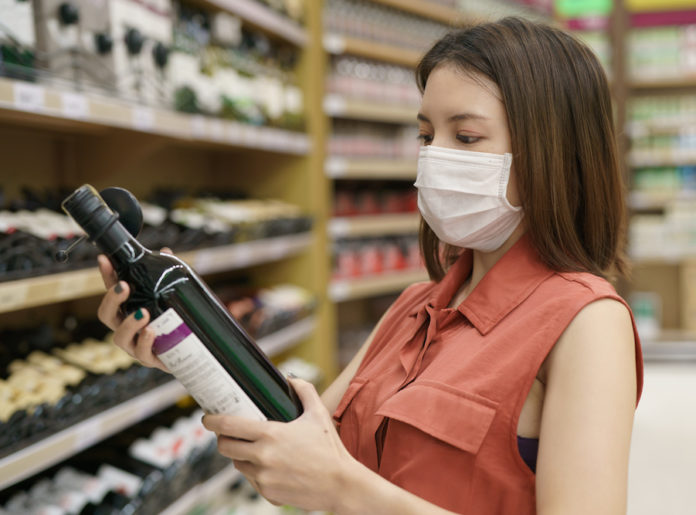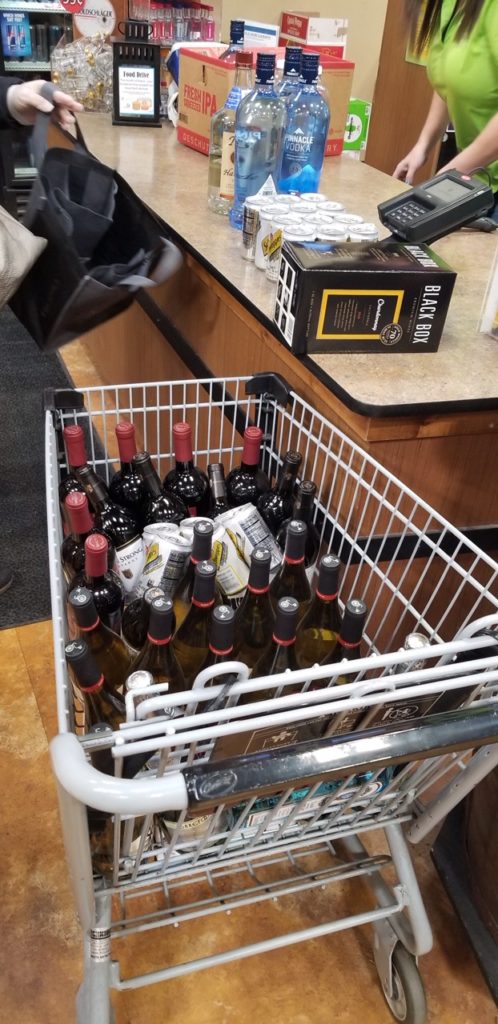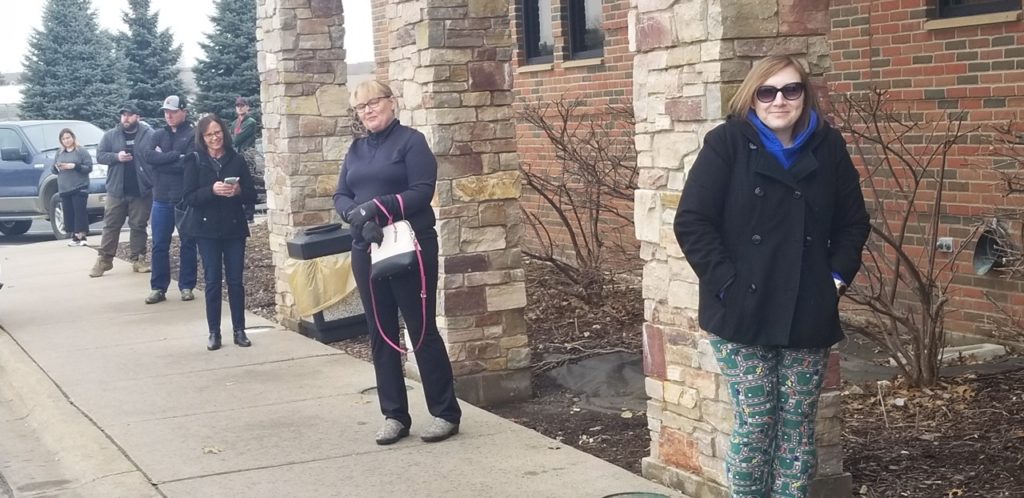
iquor stores nationwide have evolved with the coronavirus outbreak. While this crisis sadly decimated the on-premise industry, COVID-19 has sparked a sales boom for beverage alcohol retailers. Unable to visit bars and restaurants — and looking to stock up while they hunker down — consumers have patronized alcohol retailers at a high clip.
In Part 1 of this two-part series, we explored that sales boom, plus how stores responded with enhanced safety measures. In Part 2, we look at what consumers are buying, and how liquor stores have further adapted under the specter of COVID-19.
What Customers Are Buying

Suffice to say, consumer behavior has recently changed.
“In some ways it’s a return to the past,” says Edward Mulvihill, owner of Peco’s Liquor Store in Wilmington, DE. “It’s a return to what people were buying from 1995 to 2005.”
He reports a rise in customers purchasing 30-racks of beer, jug wine, 1.75-ml. bottles of vodka, and boxed wine. Those last two, both in larger formats, have been the best-sellers at Peco’s during this time of lockdown.
“People were asking me whether I had 1.75-ml. bottles of Kettle One Vodka,” Mulvihill says. “I didn’t, so I started carrying it. People are buying cases of it at a time.”
Tito’s Handmade Vodka, already immensely popular, has seen sales only climb since recent shifts in consumer sentiment. Where before Peco’s ordered Tito’s 15 cases at a time, now the store buys 50 cases at once.
“I think for consumers it’s become a situation of ‘want’ vs. ‘need’,” Mulvihill explains. “You don’t need that odd Belgian craft beer, but you do need vodka.”
Another pandemic-caused switch in consumer behavior is less exploration. Before COVID-19, the craft movement had customers jumping around brands, categories, labels and styles. Experimentation was extremely high. Now, it’s back to basics. People have limited the amount of time that they spend inside of stores, and outside of the safety of their homes, and are reaching for brands that they know and trust.
“The top SKUs for us during the last two weeks of March were, respectively, Tito’s, Maker’s Mark, Woodford Reserve and Beam,” says Jonathan Blue, owner of Kentucky’s Liquor Barn chain of stores.
Other retailers have reported similar purchasing patterns.
“Our top-selling items during this time are Kendall Jackson Chardonnay, White Claw, Tito’s Handmade Vodka, Whispering Angel Rose and Santa Margherita Pinot Grigio,” says Gary Fisch, founder and owner of Gary’s Wine & Marketplace in New Jersey.
“People are buying 1.75-ml. of everything, and box wine,” says Kevin Neitzel, owner of Fridge Wholesale Liquor in Manhattan, KS. “Box wine is by far the biggest seller, followed by Tito’s and domestic 30-packs.”

In Boston’s trendy South End, boutique wine shop The Urban Grape has noticed an odd consumer quirk given the current season.
“It’s late March, early April, in New England, and it’s dreary, grey and rainy, and we still cannot keep sauvignon blanc on the shelf,” says Hadley Douglas, who co-owns the business with her husband TJ. “Any region, we cannot keep it on the shelf.”
Why is that?
“I think people are going for strawberry, chocolate, vanilla,” Hadley says. “By that I mean that people want what they know, and what they know will taste good.”
Alcohol comfort food, in other words. And in some cases, the simpler, the better.
“I wish I had bought a pallet of grain alcohol before all this,” observes Mulvihill of Peco’s.
Liquor Stores Adapt Digitally
COVID-19 has forced rapid changes upon beverage alcohol retailers.
Despite being allowed to remain open as an essential business, Gary’s Wine & Marketplace made the difficult decision in March to close all its New Jersey locations to customer foot traffic. Their home state was among the first getting hammered by COVID-19.
Gary’s acted fast to make up for this radical business transformation.
“Since this change, our team successfully converted 100% of our in-store foot traffic to local delivery and curbside pickup orders that are placed through our mobile app and a new temporary website, www.garyslocal.com,” says Fisch. “Since March 12, we have had over 6,000 new downloads our mobile app, which offers our guests a seamless curbside pickup and local delivery experience. We intend to continue to engage with these new digital customers through push notification campaigns, high quality content and exclusive mobile app promotions.”

Urban Grape in Boston now limits customers into the store only one at a time. And the store has had most of its business move towards digital delivery and curbside pickup. For this smaller shop, built around identifying customers’ individual palates, adapting to COVID-19 meant maintaining fundamentals wherever possible.
“In that first week, we were just sending out cases of wine,” Hadley recalls. “Customers wanted us to box up and send them anything we could.”
“But we came to think, ‘This isn’t The Urban Grape’,” she adds. “Sending out bulk boxes of wine: that’s the opposite of what we believe in.”
So in their newsletter, The Urban Grape explained that it still wanted to provide the same level of personalized service it was known for — just now in a contact-free environment.
“We told customers to tell us what they wanted, what they were eating, what wines they like, so we could match them with the right bottles,” Hadley says. “For us, it was about returning to a sense of service.”
To promote this level of customer service outside of their store, The Urban Grape installed a text line over their business phone. While shopping the business’ online sales website, customers can contact The Urban Grape for wine recommendations in real time.
The store has also relied more on other digital channels.
“For us, it’s about a nonstop and completely transparent connection with customers through social media and our email newsletters,” Hadley says. “I think that has been appreciated by our customers.”
As the spreading virus keeps more consumers at home, digital delivery continues to remain popular.
“The real shining star has been delivery, which is running seven times YOY sales,” says Blue of Liquor Barn.
As American grapples with the health and economic ramifications of COVID-19, we expect more businesses to build customer connections and sales through digital avenues as the lockdown continues.
Kyle Swartz is editor of StateWays magazine. Reach him at kswartz@epgmediallc.com or on Twitter @kswartzz. Read his recent piece How Can Craft Distilling Survive The Coronavirus?









